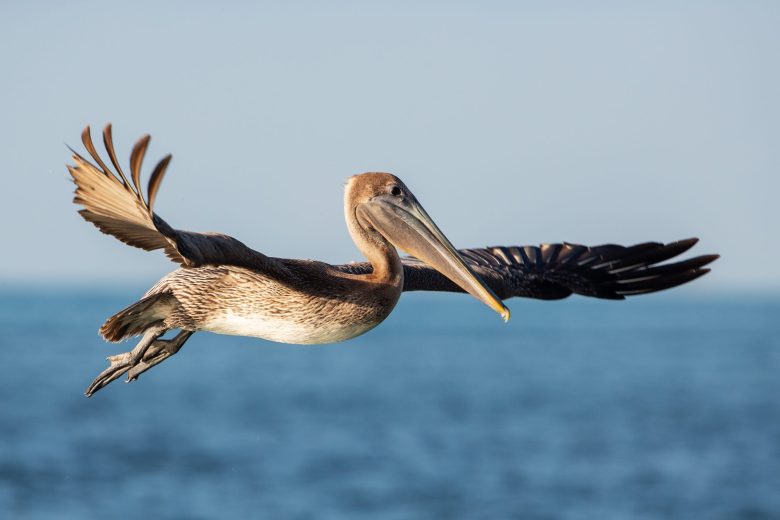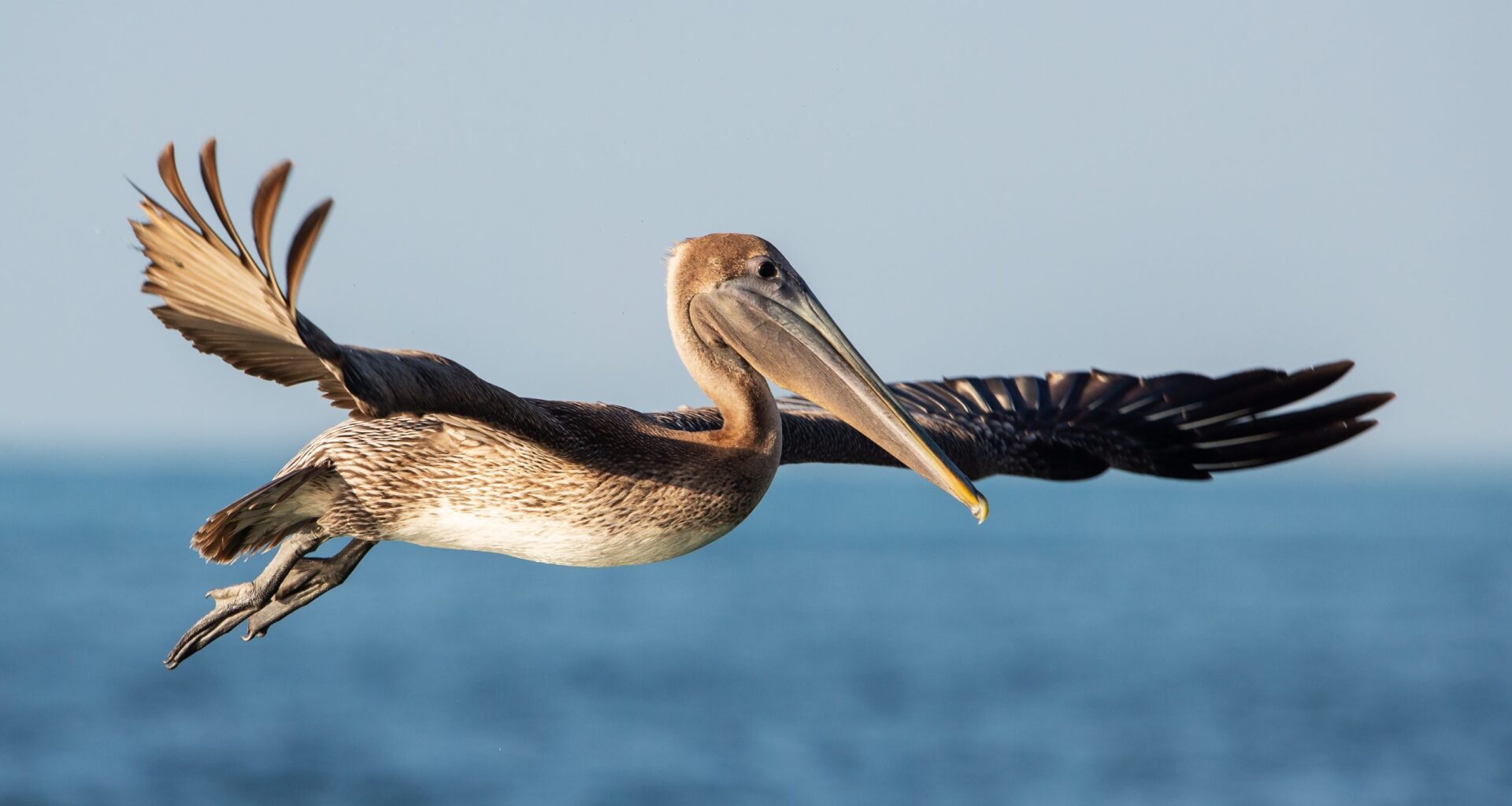 A brown Pelican in Key West, Florida Credit: Luca Nichetti / Shutterstock
A brown Pelican in Key West, Florida Credit: Luca Nichetti / Shutterstock
Fishing line is the leading cause of death for Florida pelicans, and causes thousands more deaths among birds across Tampa Bay annually. You can make a difference by joining Tampa Bay Watch (TBW) and Audubon Florida for the 32nd Annual Fishing Line Island Cleanup, October 18 to 26, or leading a cleanup at a pond in your inland neighborhood.
The TBW/Audubon event will be self-led, in which participants will travel to their designated location by personal boat or watercraft to target coastal areas where fishing lines have been caught in the shoreline vegetation. Inland, the Raptor Center of Tampa Bay is calling for neighborhoods to create their own cleanup events to prevent the needless deaths of birds, including bald eagles, sandhill cranes and barred owls.
“Tampa Bay is home to nearly 20,000 pairs of colonial waterbirds that nest in vegetation along our coast,” said Jeff Liechty, manager of Audubon Florida’s Coastal Islands Sanctuaries. “Most of the year, many of these locations are closed so that the birds are not disturbed, so it’s important that we take advantage of this window before they begin nesting.”
The islands collect vast amounts of fishing line annually – over 10,000 feet are collected some years — when fishermen accidentally cast into mangroves or hook a bird rather than a fish, then cut the line instead of trying to free it, Liechty said. Brown pelicans and cormorants are most affected, but roseate spoonbills, little blue herons and tri-colored herons also are likely to be killed by fishing line.
The coastal cleanup began in 1993 when Peter Clark, president and founder of Tampa Bay Watch, and Rich and Ann Paul from Audubon were conducting a bird survey on Passage Key and realized how many birds had been killed by monofilament fishing line.
“What was happening is that a fisherman would hook a bird and then cut the line, so the bird flew back to its nesting colony with a dangling line that became snared in the vegetation,” Ann Paul recalls. “It’s a miserable death, and then a long line trailing behind the bird means that not only does one bird die, but others become entangled.”
Then, without both parents actively caring for these young birds, the chicks are doomed too.
“When we finished the survey, we were all sitting on the boat with our sandwiches and Peter came up with the idea of a volunteer activity that would get teams of people to visit the islands to clean them up before nesting season began,” Paul said. “We’re still at it, but the best choice is always to prevent the problem by not cutting the line.”
To register for the TBW/Audubon event, contact Rachel Arndt at mailto:rarndt@tampabaywatch.org.
Not just a coastal problem
While the TBW/Audubon event focuses on coastal islands where colonial birds like pelicans, roseate spoonbills and cormorants nest, fishing line is a problem at nearly every waterbody across the region, said Nancy Murrah, president of the Raptor Center of Tampa Bay.
“The rescue organizations we work with catch and release hundreds of sandhill cranes caught in fishing line every year. There is a great blue heron entangled at a pond in Bloomingdale right now that we are about to rescue, and we respond to at least a dozen barred owls entangled in fishing lines near rivers annually,” she said. “Then, just yesterday, Polk County Animal Control rescued an entangled wood stork.”
Even bald eagles can be endangered by fishing line, she adds. “Last year, an eagle apparently brought back a fish with a trailing line for their babies in a nest near New Port Richey. Someone had released a fish with a lure and fishing line still attached, so the eagle caught it and brought it back to feed its chicks.”
When an osprey was entangled in a mess of fishing line over the Tampa Bypass Canal near the interstate earlier this year, it died before rescuers could reach it. “There are still lines and lures hanging from a cable over the canal,” Murrah said. “If someone had called us earlier, it’s possible that we could have saved the osprey.”
Although Murrah hasn’t planned a formal cleanup, she encourages neighborhoods to get together for quarterly cleanups to protect the birds in their communities. “Along with fishing line, even a small amount of trash can kill a bird,” she said. “For instance, sandhill cranes really like ear buds but they can get stuck on their bills and the birds can’t eat until they’re removed.”
Small plastic toys, particularly brightly colored pieces, can be fatal for anhingas. “We’ve seen them with pieces of a My Little Pony stuck in their beaks preventing them from eating, and I saw a gopher tortoise try to eat a piece of blue plastic because it thought it was food.”
Deaths among local wildlife, particularly those caused by fishing line and other types of litter, are reaching epic proportions. “It’s overwhelming for the rescue groups out here,” she said. “We all need to come together to prevent these kinds of needless deaths.”
How to prevent entanglements
In the event that you accidentally hook a bird when fishing, don’t cut the line! Reel. Remove. Release. Here are the steps to follow according to the Florida Fish and Wildlife Conservation Commission as part of their “Don’t Cut the Line!” educational campaign:
If the bird is feisty, it is likely healthy enough to RELEASE. Point its head towards the water and step back while you release the bird. Let the bird take off on its own. Sometimes birds shake their feathers out, assess the situation, and then are ready to fly. Other times, they just take off. Either way, this represents a successful release.
Enlist others for assistance if possible.
REEL the bird in slowly and evenly. Don’t try to shake the bird loose by jerking the line – it will inflict additional injury to the bird.
If fishing from a pier, make sure that the bird remains on the water until a net, such as a hoop net, can be used to lift it onto the pier. Birds that are reeled up onto piers can be seriously injured, or can potentially damage fishing equipment.
Wear sunglasses to protect your eyes. Take extra care to protect yourself when handling long-billed wading birds and hooked-billed cormorants.
Firmly grasp the bird’s head behind the eyes. Then fold the wings up gently but firmly against the bird’s body so that it can’t flap its wings, and hold the legs. Hold firmly but don’t strangle the bird. If it is a pelican, you can hold the beak but keep the beak slightly open so the bird can breathe.
Cover the bird’s head with a towel, hat, shirt, or other cloth. This will calm the bird and make it easier for you to remove the line and/or hook.
REMOVE the hook by cutting the barb and backing the hook out. If the barb is embedded in the bird’s flesh, push the hook through until the barb emerges from the skin and then clip the barb.
If the bird is entangled in line, use scissors, clippers or a knife to gently cut the line. Place the cut line in a monofilament recycling bin, or cut the line into small (< 3-inch pieces) and place in a lidded trashcan.
Carefully check the bird over for other hooks or line and remove them too.
This post first appeared at Bay Soundings.
Subscribe to Creative Loafing newsletters.
Follow us: Google News | NewsBreak | Reddit | Instagram | Facebook | BlueSky
This article appears in Oct. 16 – 22, 2025.
Related

